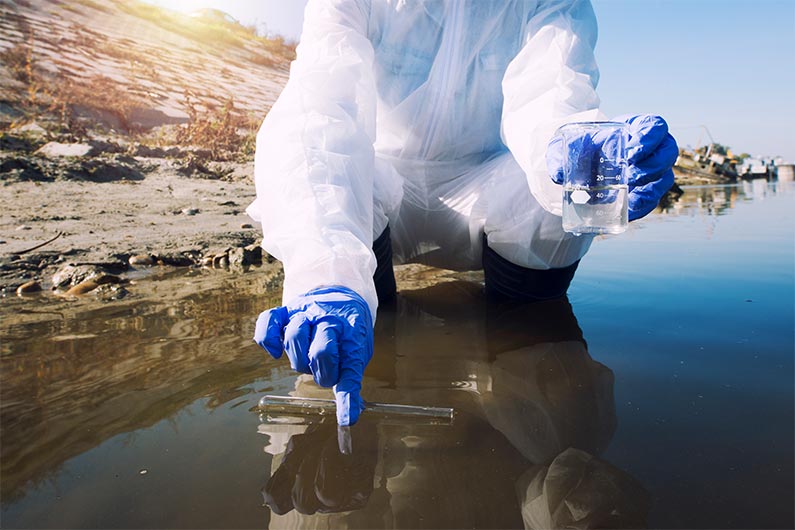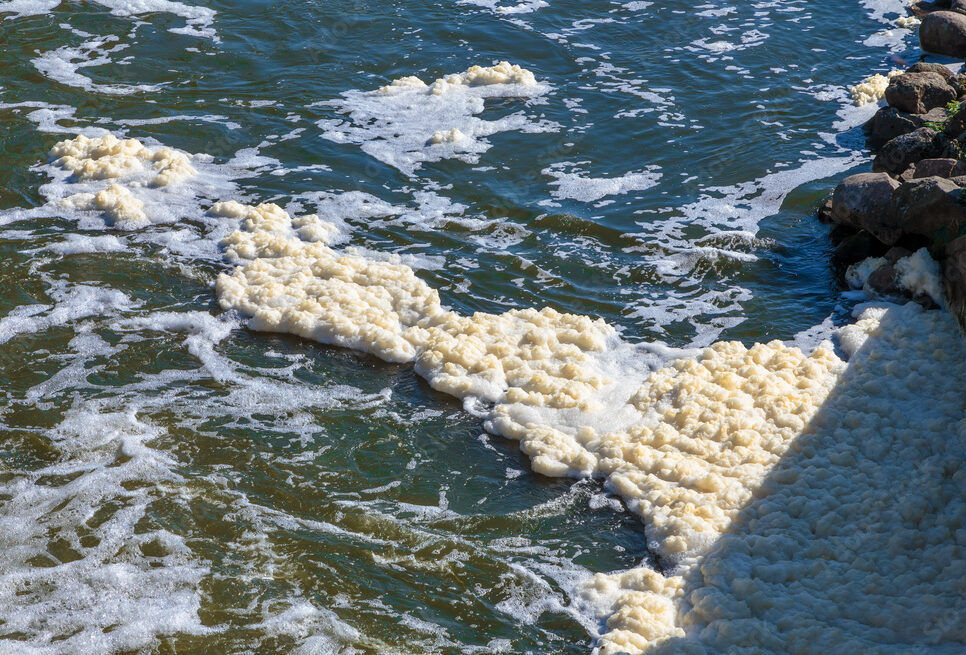
In this article, we will discuss PFAS remediation in the UK. We will focus on both water and soil treatment. First, the article reviews the chemical structure of the PFAS compounds then discusses remedial methods. We will also discuss the UK government’s response to PFAS contamination.
What are PFAS Chemicals?
The more common abbreviation for these chemical substances is PFAS. Due to their strong carbon-fluorine bonds, PFAS are persistent in the environment and the human body, meaning they do not break down easily and can accumulate over time. These properties have made PFAS useful in a wide range of consumer products and industrial applications, including non-stick cookware, water-repellent fabrics, stain-resistant carpets, electronics, and firefighting foams. However, their persistence and bioaccumulation potential raise concerns about environmental and human health impacts.
PFAS has two main subcategories: PFOA and PFOS.
PFAS (Per- and Polyfluoroalkyl Substances) are a large family of synthetic chemicals, including PFOA (Perfluorooctanoic Acid) and PFOS (Perfluorooctanesulfonic Acid). These chemicals are structurally similar but differ in their carbon chain lengths and functional groups; PFOA contains a carboxylic acid group, while PFOS contains a sulfonic acid group. Both are known for their persistence in the environment and potential health risks, but PFOS is often considered more toxic due to its stronger bioaccumulation properties.
What are the remediation methods for PFAS in the UK?
PFAS pollution remediation has several practical procedures in the UK. These procedures aim to reduce or even remove such persistent chemicals. Mainly, these processes are focused on soil and water drainage. Here are some of the remediation methods commonly used for PFAS in the UK:
- Excavation and disposal
- Soil washing
- In-situ treatment with amendments
- Activated carbon filtration
- Ion exchange
- Advanced Oxidation Processes (AOPs)
- Bioremediation
- Novel technologies and innovations
Choosing the right and effective remediation methods depends on the extent of contamination and site characteristics.
Different compound bases in PFASs also help select the right remediation method. More often, the most suitable solution can only be offered by an on-site approach. This sorts out the complex PFAS contamination. Compliance with regulations is also pivotal for remediation methods in the UK.
John F Hunt Regeneration is dedicated to providing viable and environmentally responsible methods for removing PFASs from groundwater. Our team of engineers and scientists has the know-how to determine the extent of PFAS contamination, create and carry out remedial techniques, and monitor the performance of treatment facilities.
Learn more about our groundwater remediation services.

PFAS soil remediation: Techniques
Regarding environmental management, PFAS soil remediation is a crucial concern. This aims to reduce soil pollution with such persistent substances. Different clean-up approaches are applied effectively in these case scenarios. Every technique has its own strengths and weaknesses. In the following, we will explore key techniques for PFAS soil remediation:
Excavation and disposal
The excavation process is used to remove PFAS-contaminated soil. Finally, the soil is transferred to a safe site for disposal. The method could be considered adequate for localized contamination. It can also be used in spill sites with high concentrations of PFAS pollution.
The procedure is firmly grounded and has extensive application in different PFAS types. However, this method may not suit large-scale contamination.
Soil washing
The process of soil washing involves physical and/or chemical methods. Soil washing is a technique for separating and recovering PFAS from soil particles. This method could be applied to the soil with moderate-high levels of PFAS, including both onsite and offsite treatments.
It can also be fine-tuned for different PFAS compounds and used in most soil types. However, it is essential to note that such a procedure is not suitable for minor pollution levels as it also produces wastewater that needs to be cleaned.
Bioremediation
Breakdown of PFAS in soil by using a bioremediation process involving microorganisms. The sustainability and low-impact approach make it well-suited for more minor PFAS levels and straightforward contamination situations. However, before we conclude this chapter, it is necessary to note that this technique requires a more extended treatment duration.
Thermal treatment
The use of heat is referred to as thermal treatment on contaminated soils. Done in situ or ex-situ, it aims to eliminate PFAS by vaporizing them from the ground. This technique is effective for many PFAS compounds and concentrations, making it suitable for both site-specific and non-site-specific uses, respectively. The application of this method is widespread among different soils owing to its high removal efficiency. All include high energy requirements and site disturbance.
Solidification/Stabilization
In solidification/stabilization, additional materials are added to PFAS-contaminated soil to restrict flow or movement and minimise leakage. The technique applies to soils with medium pollution and confinement without removal. However, it ought to be noted that this approach may not work for all PFAS types.
Phytoremediation
Plants serve as a removal agent for soil-based PFAS through phytoremediation. It is effective for low amounts of PFAS. This method is environmentally friendly. However, its effect at high concentrations is doubtful and is highly dependant on environmental conditions on the site in question (such as oxygen levels, pH and temperature)
Summary
There are several approaches where such soil remediation techniques can be employed to reduce PFAS contamination. Often, multiple remediation techniques used in conjunction are more effective compared to just one, each with unique benefits and limitations. Excavation and disposal are used for localized, high-concentration contamination, whereas soil washing separates PFAS from soil for moderate to high levels of contamination but produces wastewater. Bioremediation utilizes microorganisms for sustainable, low-impact treatment, suited for low-level contamination. Thermal treatment vaporizes PFAS, offering high removal efficiency but at high energy costs and the potential creation of complex daughter compounds. Solidification/stabilization confines PFAS in soil, and phytoremediation uses plants for low-level contamination, though its effectiveness varies with environmental conditions
Tackling PFAS in water: Effective treatment solutions

Treating water contaminated with PFAS presents significant challenges due to the chemicals’ robustness, high mobility and resistance to degradation. Traditional water treatment methods struggle to remove these substances effectively. Let’s discover the current treatment solutions for PFAS in water:
Activated carbon filtration
PFACS contaminants are efficiently removed through the activated carbons filtering process. This is done by passing filtered water through beds of porous carbon. It’s generally utilized in water treatment. This approach is frequently applied in water treatment where sorbent is feasible.
Ion exchange
Ion exchange utilizes resins. The purpose is to substitute PFAS ions in water with other ions and eliminate PFAS from water.
Osmosis
Osmosis, specifically reverse osmosis, plays a critical role in the removal of PFAS from water. This process involves using a semi-permeable membrane to filter out PFAS molecules, effectively separating them from water. Due to the small size and complex chemical structure of PFAS compounds, reverse osmosis is one of the few methods capable of significantly reducing their concentration in contaminated water.
Coagulation/Flocculation
In coagulation/flocculation, chemicals are added to water. It promotes particle clumping. It also provides a basis for sedimentation and filtration of PFASs. The application of this approach includes drinking water and industrial wastewater treatment.
Advanced Oxidation Processes (AOPs)
AOPs involve the generation of highly reactive species, especially hydroxyl radicals, under specific conditions that lead to the breakdown of PFAS compounds. These processes can effectively degrade PFAS, transforming them into less harmful substances.
Biological treatment
Biological solutions for PFAS treatment involve utilising microorganisms that can break down these persistent chemicals, a well-developed remediation technique already widely used for heavy metal and hydrocarbon pollutants. While PFAS are notoriously resistant to degradation, certain bacteria have shown the potential to decompose PFAS compounds under specific conditions. This approach is still under research but offers a promising avenue for environmentally friendly and sustainable PFAS remediation strategies. The effectiveness of these biological methods varies depending on the PFAS structure and environmental conditions, highlighting the need for further study to optimize and apply these treatments effectively.
Learn more about our water treatment technology services.
The development of cutting-edge solutions for the treatment of PFAS
These innovations paved the way for progression in science and technology. Modern practices seek to combat these issues associated with recalcitrant pollutants. Innovative methods for PFAS water remediation are explored in this section:
Advanced oxidation processes (AOPs)
The high-energy hydroxyl radical from AOPs degrades PFAS molecules through an oxidation process. The technique works well for many PFAS compounds in water and can be used in situ and ex-situ.
Electrochemical treatment
Electrochemical treatment for PFAS involves using electric currents to degrade these persistent chemicals in contaminated water. This process can effectively break down PFAS compounds into less harmful substances, offering a promising approach for mitigating their environmental and health impacts. The method leverages the electrochemical properties of PFAS to target and destroy their strong carbon-fluorine bonds, thereby reducing their concentration and toxicity. This technique is being explored as a viable and efficient solution for treating PFAS-contaminated sites, with ongoing research focusing on optimizing its effectiveness and applicability.
Nanomaterial-based filtration
Adsorption utilizes adsorbents such as nanomaterial filtrations and activated carbon or metal-organic framework filters (MOF). Nanomaterial-based filtration represents a cutting-edge approach in the treatment of PFAS-contaminated water. Leveraging the unique properties of nanomaterials, such as high surface area and reactivity, this technology can selectively remove PFAS molecules from water sources.
Membrane technologies
For removal of the PFAS, advanced membranes such as reverse osmosis or nanofiltration, which depend on size and charge differences, are used. This approach works well with many PFAS compounds, including wastewater treatment plants and industries.
Biological treatment
Biological treatment involves breaking down PFAS compounds in water using bacterial enzymes for decomposition. It is an environmentally sustainable way.
The future of PFAS treatment
Research continues to evolve at pace, with ongoing studies exploring the efficacy, scalability and sustainability of these solutions. New PFAS destruction methods can help the UK reduce PFAS exposure and mitigate contaminants’ persistence in the atmosphere, soils, sediments, and biota. These innovative methods offer a more comprehensive solution for PFAS compound destruction, including:
- Peroxidation-activated carbon treatment
- Plasma-based destruction
- Advanced hydrothermal oxidation
- Enzymatic degradation
Further Thoughts
A critical step in managing PFAS challenges involves early engagement with experts, including specialist remediation contractors, environmental consultants, and legal advisors. These professionals can provide invaluable insights into the nature of PFAS contamination, the latest remediation technologies, and evolving regulatory requirements. Collaboration with regulators is equally crucial, ensuring that remediation plans meet current standards and anticipate future changes. This proactive engagement helps in devising strategies that are both effective and compliant, minimizing potential liabilities and facilitating smoother project progression.
Adopting a bespoke remediation approach is essential, given the unique characteristics of each site and the specific PFAS contaminants involved.